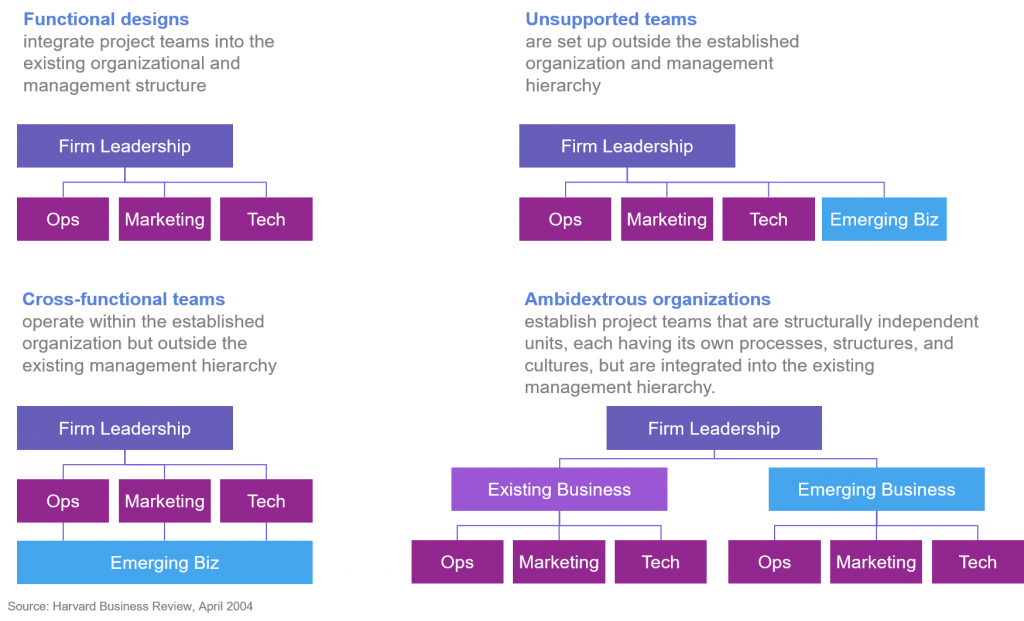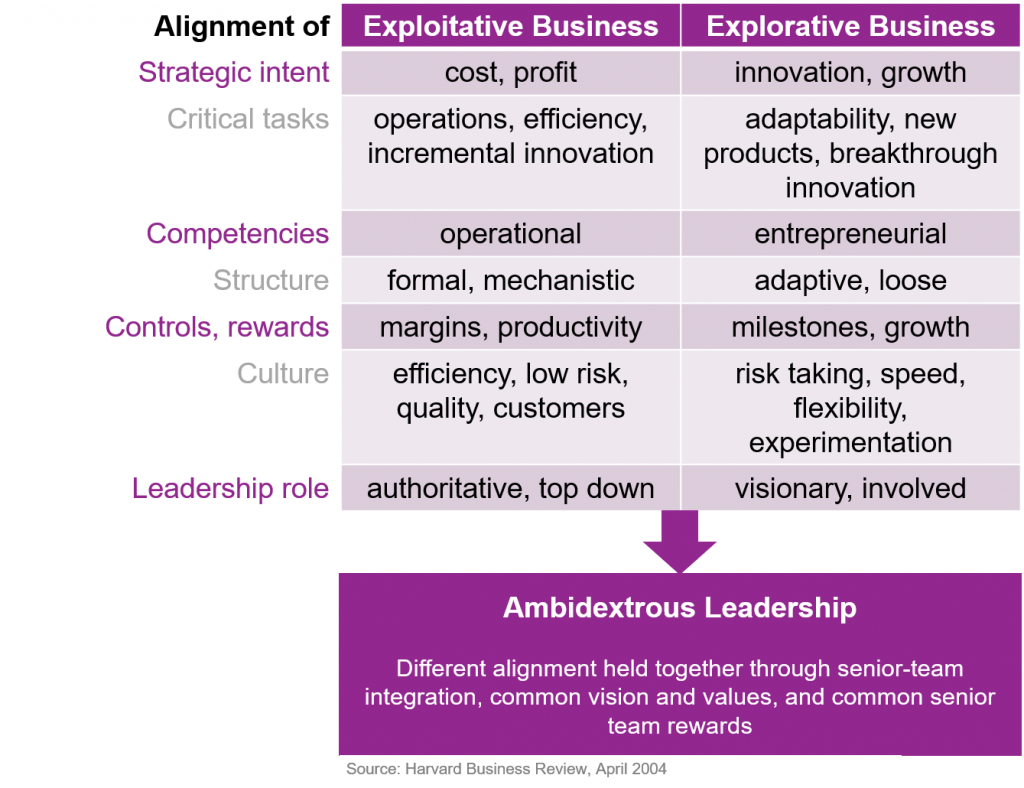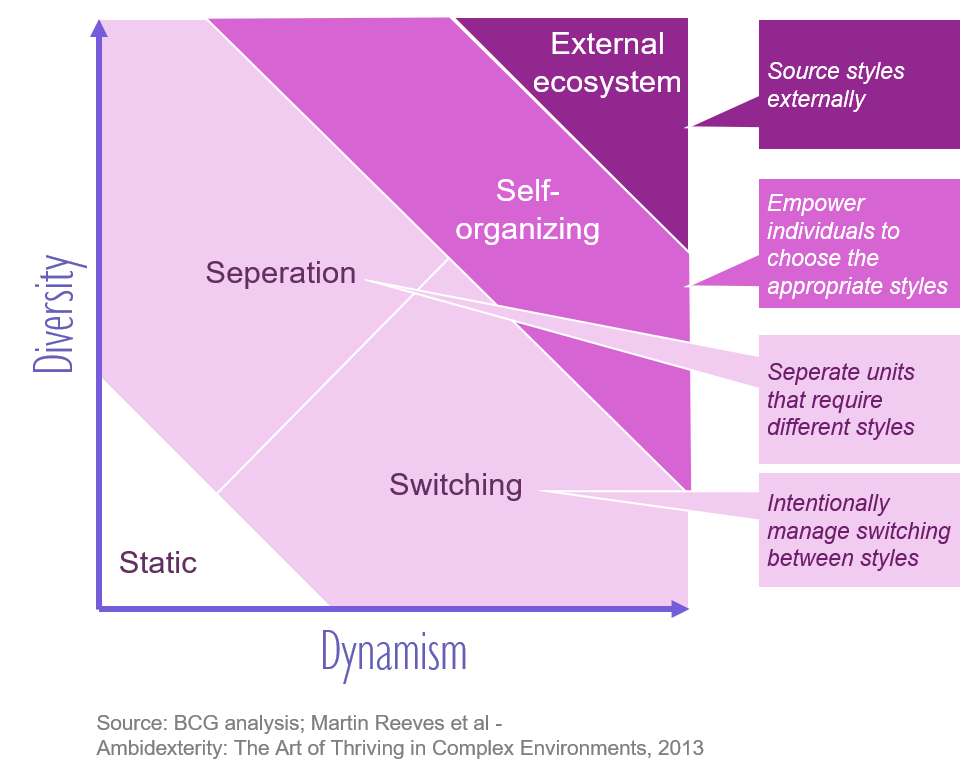An article by Sebastian Hartmann and Hans-Werner Winterhoff, September 2019
Professional service firm leaders are faced with a difficult situation these days: Intense traditional and new technology-backed competition, smarter clients and shifting demand patterns are pushing them to cut costs and drive delivery and overall efficiency. At the same time, the increasing pace of change means they need to emphasize innovation and invest more than ever before. And all of this while maintaining ever higher partner and employee salaries and bonus levels.
This balancing act has been described as one of the toughest of all managerial challenges – and it is no surprise that professional services firms struggle just as much or even more than their clients (see our previous article). Charles A. O‘Reilly III and Michael L. Tushman have investigated this challenge, the possible theories for handling it and especially the companies, who are actually capable of exploring „new opportunities even as they work diligently to exploit existing capabilities“ (HBR, April 2004). Their examination revealed the special importance of organizational structures for this particular challenge. They discovered that more than 90% of those using a so-called „ambidextrous structure“ succeeded in their innovation attempts, while none of the cross-functional or unsupported teams, and only 25% of those using functional designs, reached their goals.

Given the natural resistance to change in PSFs and the inherited traditional playbook and organizational structures in these firms, it seems ironic but nonetheless perfectly fitting to quote BCG’s Bruce Henderson: „Success in the past always becomes enshrined in the present by the over-valuation of the policies and attitudes which accompanied that success“.
So, with fundamental change running deeply into and across professional services, the concept of ambidexterity appears to be more relevant than ever – and one of the keys to the design of next generation PSFs.
So what does it mean and take to become ambidextrous?
Ambidextrous firms encompass two profoundly different types of organizations and businesses – those focused on exploiting existing capabilities for profit, and those focused on exploring new opportunities for growth. The following table explains the different strategies, structures, processes, and cultures:

Achieving ambidexterity and thus combining both worlds under one organizational roof, requires professional services firms to become much more aware of the distinct characteristics of their different service areas and specific solutions. At this point, we would like to stress the importance of understanding a firm‘s portfolio through a client-centric solution lens – and then applying this lens rigorously across strategic management decisions (see this article on Strategic Management in Professional Services, June 2019). A key element of this understanding, which goes way beyond the traditionally emphasized focus on partners’ sales contributions, utilization figures and vague groupings of similar capabilities: Regularly assessing the market environment and competitive position of your specific solutions and solution clusters. While this may seem like a tediously granular exercise, it pays respect to the wide range of differences between underlying business models in professional services – even within the same general field of expertise or capability.
Here is just one example from the tax advisory space: The robot-invaded field of corporate tax declaration work has experienced strong commoditization for a while now – reflecting previous similar developments for consumers. Meanwhile, tech players invade the traditional high value M&A tax space with artificial intelligence or partner with traditional firms, which fight for differentiation. At the same time, the field of tax services for global workforce mobility has drifted into managed services. And all of this happens simultaneously for many tax advisory firms, creating a number of different challenges per field and for the portfolio of a firm in general (e.g. a changing performance-risk-profile). It is therefore important for professional services firms to understand that their business is often way more diversified than it appears to be at first glance. Obviously, those differences in larger and even more explicitly diversified firms (e.g. those combing accounting, tax, legal and/or consulting services) are becoming even more amplified and disparate. Innovation and strategic portfolio management needs to be aware of those differences and work together with the general leadership and the business unit management on the right setup for each area: A setup which allows the organization to thrive in each of its distinct fields of business and, of course, collectively.
Key takeaway: Understanding a firm‘s environment allows leaders and managers to apply the right strategic approach and consider exploitative and explorative opportunities – and thus derive potential ambidexterity options.
Because the general concept of ambidexterity creates a number of potential setup options, we would like to review a few concrete ideas and a framework, which has been outlined by Martin Reeves et al.. Ideally the data required for the decision framework below, is a linked subset of the strategic portfolio shown above. This will ensure that strategic directions and organizational implications are aligned as early as possible.
The ambidextrous decision and journey
The general idea of the framework below: Once a professional services firm understands the diversity and dynamism of its different solution environments (as an analytical subset of the overall portfolio status), it can choose a suitable approach to ambidexterity. This approach may differ depending on the need to exploit and / or explore. Each approach then requires a specific organizational setup and different leadership and management style. The following options thus need to be considered in the context of the PSF-particular cultural heritage, resource situation and, of course, competitive positioning.

Separation: Keeping some distance
This approach emphasizes boundaries between exploiting (scale and efficiency focused) and exploring (innovation driven) business areas. Leaders need to design these boundaries and manage the chasm of different objectives, resources and policies for different areas. Creating an understanding amongst professionals for these differences and paying equal respect to each unit, is particularly important in the people-based nature of PSFs. At the same time, leaders need to make sure that the units do not drift too far apart – especially given the scarce financial resources, important brand foundations and partnership structures in many PSFs. The interplay (e.g. cross- and up-selling) between different units is still important and must not fade into transactional relationships and isolated, siloed units.
Switching: The adaptive core
This approach requires a highly adaptive core, where different functions like HR, marketing, IT can meet changing needs of different groups over time. The leadership needs to consciously manage frequent transitions in style, drive integration and collaboration – and especially a culture of flexibility across all management levels. Keeping strategic alignment may be a vital challenge across larger groups of professionals. We advise a careful assessment of this tempting approach, which may seem appealing and responsive at first, but can turn out too messy and difficult to handle at scale.
Self-Organization: The guardrails of freedom
Based on the strong characters assembled in many professional services firms, this approach may hold some special appeal: It grants individual units the freedom and flexibility to define their own setups, but enforces rules of interaction between the individual units. The center and leadership of these firms thus evolves into the role of a „network designer“, who ensures the integrity and effectiveness of the firm across a wide range of particular business environments. A certain degree of local independence still reigns the DNA of many larger professional services firms (e.g. the Big Four accounting firms, the magic circle law firms or large marketing agency networks). However, they often struggle with their clients‘ demand for increasingly digital solutions at scale across their global networks. Financial and technology management are showing up as frequent and critical hurdles. We would therefore emphasize that ambidexterity in this context should not be mistaken for isolation or euphemistic independence. It is a daunting but achievable educational challenge to develop these firms and their mindsets towards increasingly scalable, digital, consciously managed, designed and operated solutions as well as innovative, responsive and collectively efficient setups.
External Ecosystem: Providing the greenest field imaginable
This approach is all about creating multi-sided marketplaces: These platforms need to attract partners, suppliers, clients and put the professional services firm into the role of an orchestrator and coordinator of an ever-expanding ecosystem. While this approach can be observed at frequently cited disruptive players (e.g. AirBnB, Lyft, Apple, Google, Netflix etc.), it is still difficult to visualize in the context of professional services. However, we should be aware of new professional service players (e.g. in legal tech) and the evolving regulatory perspective (e.g. in international tax or data standards, like Engine B), which increase the dynamism in many areas. This approach is likely to gain importance as professional services firms turn towards new and more diversified business models with their innovation efforts.
The forces of inertia in many professional services firms are strong and ambidexterity is tough to master. But research and practice show that is possible for a professional services firm to renew itself without destroying its traditional business. While the term “ambidexterity“ has a tone of unnecessary complexity to it, the concept itself is simple to understand. The outlined approaches above need to be carefully and continuously assessed though – and applied with rigor accompanied by sound cultural change management. But we believe that any firm can achieve ambidexterity – given their leaders are willing to embrace the journey.
Follow me on LinkedIn or Twitter for regular updates and information about Professional Service Firm management and leadership: #NextGenPSF
Looking forward to hear your thoughts!